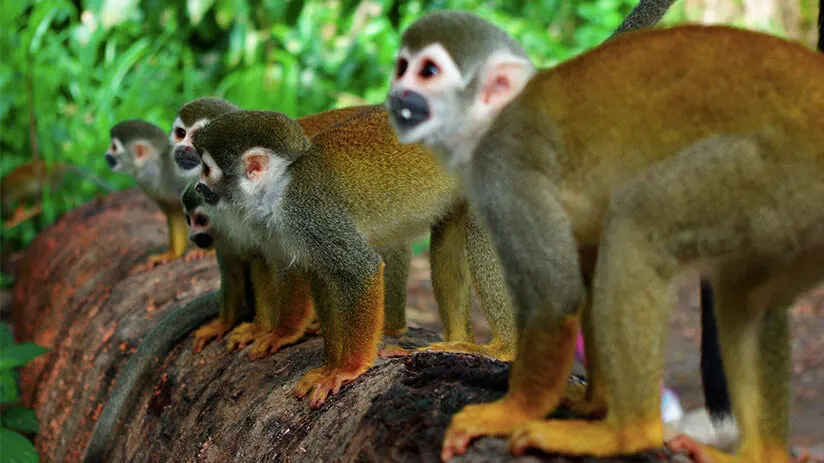Most individuals who aspire to visit the Amazon in Peru do so to witness its magnificent wildlife. The Amazon rainforest animals certainly set the trend regarding popular tours of America. The largest rainforest in the world, the Amazon, has excellent biodiversity. Many even recognize the Peruvian Amazon for its climates, natural settings, and exotic specimens.
Keep in mind that many of these animals are possible to see if you enter the different reserves or national parks. But how many animals are in the Amazon rainforest? Amazon is one of the most biodiverse areas on the entire planet. So, you can expect more than 100,000 species of invertebrates, 3,000 species of fish, 380 species of reptiles, and more than 400 amphibians.
Not to mention more than 400 mammal species and 1,300 species rich in birds or 40,000 plants. Therefore, we invite you with Machu Travel Peru to meet the most amazing of these species!
The IUCN cataloged the state of earth species in 7, going from more grave to least. By the way, the IUCN is the International Union for Conservation of Nature.
| NOMENCLATURE | ACRONYM | DESCRIPTION |
| Extinct | (EX) | The end of the species around the world, both in wild and/or known areas and in places of captivity. |
| Extinct in the wild | (EW) | Species that are extinct in their wildlife. A few survive in captivity areas. |
| Critically endangered | (CR) | These species are afront a high level of extinction around the world (Without area distinctions) soon. |
| Endangered | (EN) | Definitely, these species will be extinct in a particular zone or region. Due to foreign species, habitat loss, or poaching. |
| Vulnerable | (VU) | This means that the species here are at a high level of extinction in their wildlife. Unless the factors that threaten their reproduction and survival improve. |
| Near-threatened species | (NT) | These species can be endangered soon. |
| Least-concern species | (LC) | Species that are not in danger of extinction now or soon. |
Know more about these 30 fascinating Amazon rainforest animals!
- Amazon rainforest mammals
- Amazon rainforest birds
- Amazon rainforest reptiles
- Amazon rainforest amphibians
- Amazon rainforest fish
- Amazon rainforest insects
Amazon rainforest mammals
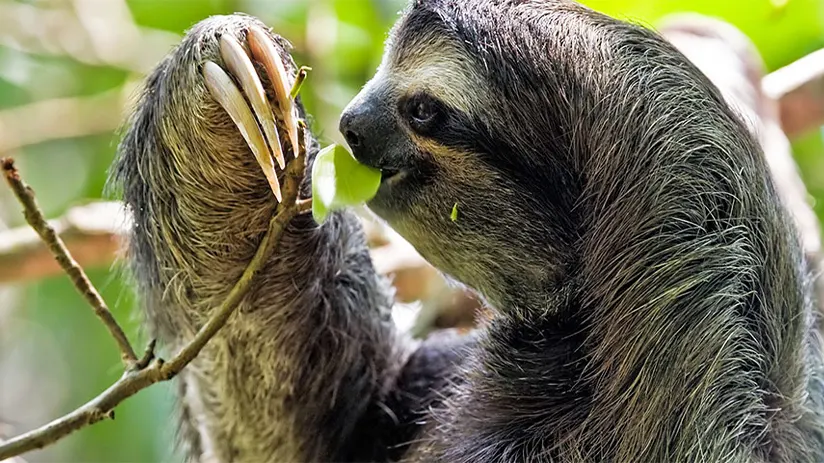
The largest rainforest in the world, the Amazon, is a true nature paradise for thousands of species. There, the stealthy jaguar, the boisterous macaw, or the imposing black caiman can live free without human presence.
They even develop their tasks within the natural food chain without any alteration by external factors. This is not to mention the more than 400 species of mammals that inhabit the area. And coincidentally, the Peruvian Amazon hosts the majority of them. Therefore, a trip to Peru without seeing these amazing animals would be a severe mistake.
1. Jaguar (Otorongo)
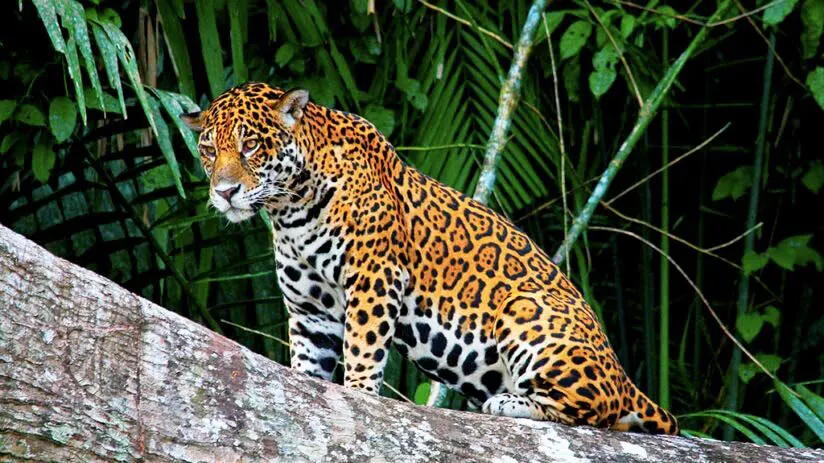
| Where to see them | Tambopata Research Center (Tambopata National Reserve) |
| Condition | Super Predator (Predator that hunts other predators) |
| Extinction Status | Near threatened species (NT) |
The jaguar or Otorongo (A local Peruvian name) is one of the most characteristic Amazon animals in South America. This animal is the largest wild cat in South America. Otorongo is also the third largest in the world, following the lion and the tiger.
Not many travelers are lucky enough to spot this iconic jungle animal. They are solitary predators that hunt at night and sleep during the day in treetops or by river banks. The jaguars had muscled bodies, broad heads, and heavy bites.
Moreover, jaguars are good swimmers, excellent climbers of trees, and exceptional jumpers. Their diet consists of tapirs, capybaras (ronsocos), peccaries, deer, anacondas, and even other black caimans.
Usually, you will have to go far into the Amazon to have a chance to photograph a jaguar. However, the Tambopata National Reserve is the place where you will have the best chance of seeing it. Even the Tambopata Research Center gives the chance to see them in a reduced area.
2. Giant river otter
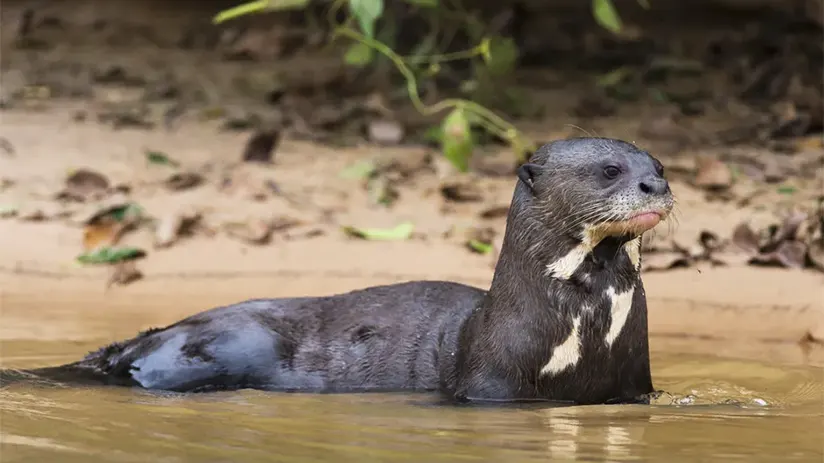
| Where to see them | Manu and Pacaya-Samiria National Park. |
| Condition | Carnivorous. Diet of fish, crabs, small caimans, and anacondas. Its predators are humans, jaguars, black caiman, and anacondas. |
| Extinction Status | Endangered species (EN) |
Giant river otters are one of those Amazon rainforest animals that you don’t want to miss seeing. The biologists recognize them as the largest otters on earth. They can measure up to about 1.7 meters (5.6 feet).
Otters find a home through the different lakes and banks of slow Amazon rivers. This fact is to protect the safe growth of the youngest. Therefore, they live in large families of 4 to 10 members (herd) to protect themselves from jaguars or black caimans.
These giant otters also feed fish, crabs, and even small caimans and anaconda.
Without a doubt, the giant river otters are the best example of the biodiversity in Peru. You can watch these adorable animals pop up above the river or relax on logs in the middle of the water. They swim with their webbed feet, muscular tails, and thick fur.
Unfortunately, the hunters have hunted these animals excessively by their fur in past years. So now they are an endangered species.
3. Red howler monkey
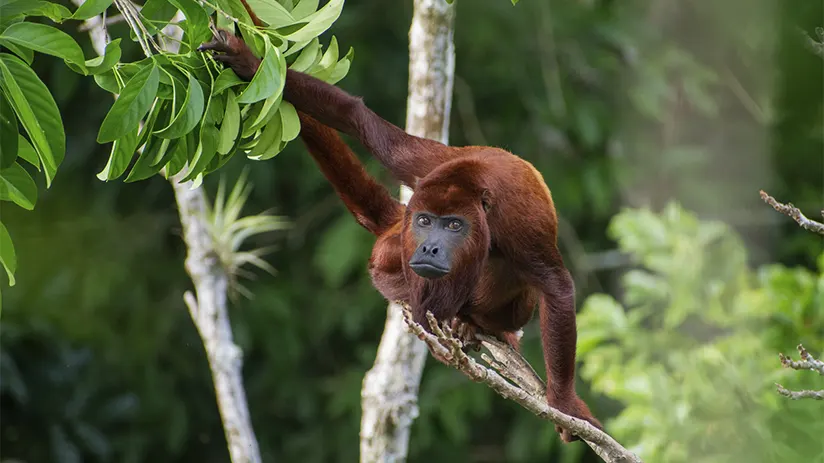
| Where to see them | Pacaya Samiria National Park and all north of South America. Near Puerto Maldonado (South of Peru), there are refuges where you can see these animals, too. |
| Condition | Vegetarians. Its predators are humans, jaguars, and anacondas. |
| Extinction Status | Least Concern species (LC) |
Anyone who steps into the Peruvian jungle can be sure that he will hear the red howler monkeys. One can distinguish their screams from up to 5 kilometers away (3 miles). These animals are monkeys of orange-red fur with bare faces and free of hair. Its diet consists mainly of leaves, fruits, and flowers.
These diurnal monkeys usually live in large families of 6 to 16 members and live on the tops of medium and high trees. If you’re seeking additional opportunities, you’ll need to venture further into the Amazon. However, in Puerto Maldonado’s top refuges, you can see many of these monkeys. Keep your sight on the treetops to photograph this charming animal!
4. Capybara (Ronsoco)
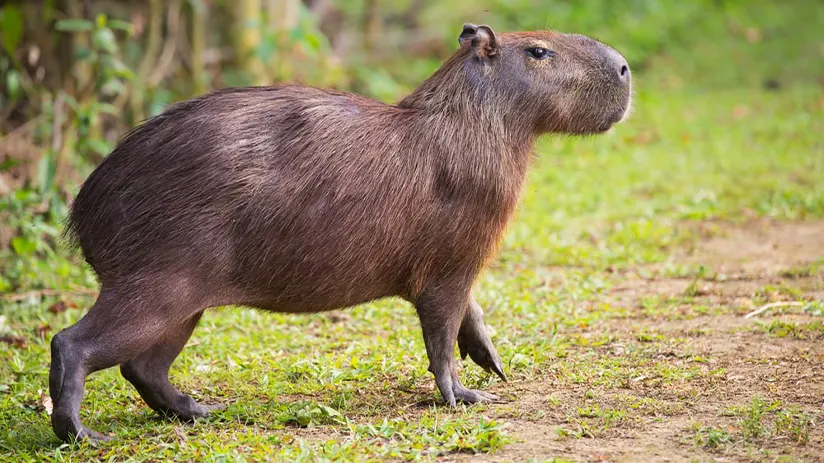
| Where to see them | Manu and Pacaya Samiria National Park. Also all east of the Amazon region in South America. |
| Condition | Vegetarians. Its predators are humans, black caimans, jaguars, and even anacondas. |
| Extinction Status | Least Concern species (LC) |
One of the most charming rodents in the Peruvian jungle. Ronsoco is the other local name of Capybara. They are pretty docile rodents with barrel-shaped bodies and small heads with reddish-brown fur. They tend to reside in the lushest and most heavily wooded areas of South America.
During the day, Ronsocos can stay in a hole or under the water, sticking its head out every five minutes. At night, they often sleep on the grass outdoors. However, they tend to choose regions of freshwater bodies and go out in the middle of the twilight to feed themselves.
The Capybaras are also good swimmers and can go underwater without breathing for a long time. Usually, they can live in couples or groups of 6 to 20 members. However, there is a register of solitary members wandering. Their diet consists of grass and aquatic plants.
Moreover, the biologists consider them the largest rodent in the world. They can grow to be about 1.2 meters or 4 feet long and up to 2 feet or 60 centimeters high! One of the best things to do in Iquitos.
5. Black-capped squirrel monkey
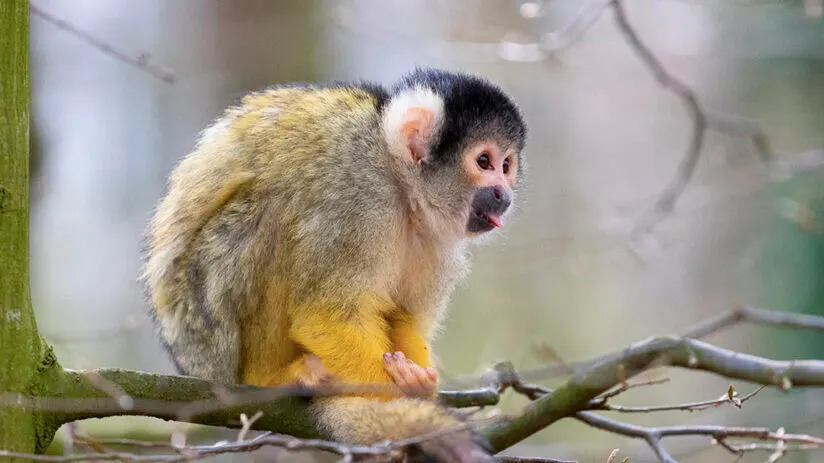
| Where to see them | Manu National Park and Tambopata National Reserve. |
| Condition | Vegetarians and insectivorous. Its predators are humans, jaguars, harpy eagles, and even anacondas. |
| Extinction Status | Least Concern species (LC) |
The black-capped squirrel monkey is an Amazon animal that you will want to photograph in its natural habitat. Visitors can see them in many Bolivia, Brazil, Ecuador, and Peru regions, including the Amazon. The Black-capped squirrel monkey has a white face, brown snout, and a lock of black hair.
These monkeys often stain their hands with urine to demarcate their territory whenever they climb trees. They are sociable and tend to live in matriarchal hierarchies. There, the female dominate groups of up to 75 monkeys.
Furthermore, they reside midway up trees, not too high to be spotted by harpy eagles, yet not too low to be accessible to Jaguars.
These monkeys receive the appellative Squirrel for their agility in climbing trees. Unlike other species of monkeys, they use their tails to balance and not to climb. Also, the squirrel monkey has a great vision to locate fruits and insects, the main ingredients of its diet.
Even some specialists affirm that this monkey is intelligent. This fact is because they have the highest brain mass compared to their bodies. Moreover, this advantage is in comparison all monkeys types. A specimen that is worth seeing within the different Amazonian routes.
6. Collared anteater
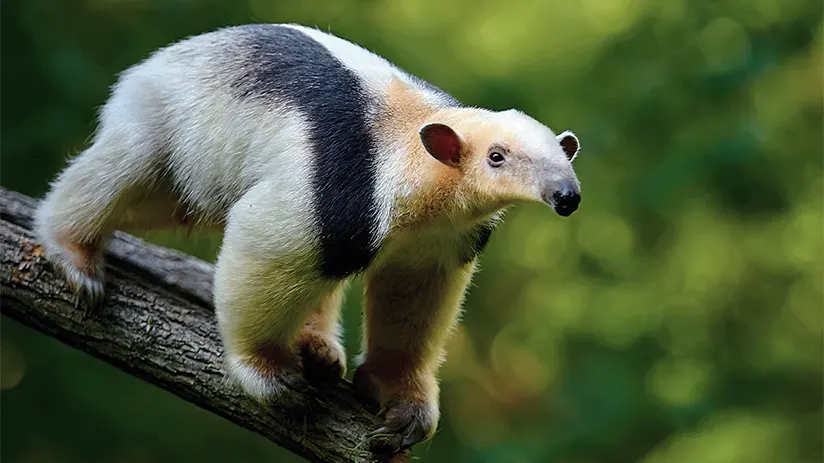
| Where to see them | Pacaya Samiria National Reserve and Manu National Park. |
| Condition | Insectivorous. |
| Extinction Status | Least Concern species (LC) |
Many anteater specimens call the American continent home. But the species of the collared anteater is unique in all of South America. These creatures in the Amazon jungle have elongated, furless faces, and pointed ears.
Without mentioning their fur, which is a shade of melon in the form of a vest on their backs. Collared Anteater is solitary and often has an active life at night and sleeps during the day. By the way, they are way smaller than the well-known giant anteaters.
They have the ability and facility to climb trees and thus look for termites or ants. These trees must be near streams and rivers in humid and dry forests, tropical rainforests, jungles, savannahs, and mountains. They have tongues that can be up to forty centimeters long (about 15 inches). Also, Collared anteaters have a diet of a wide variety of insects.
7. Sloth
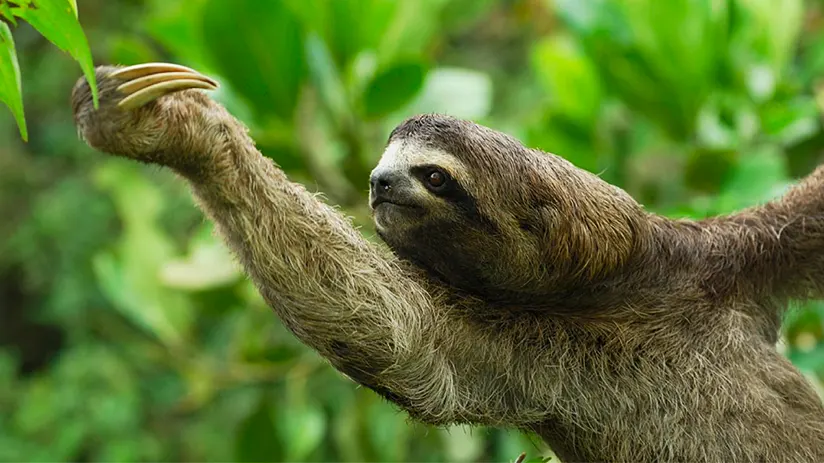
| Where to see them | Pacaya Samiria and Tambopata National Reserve. |
| Condition | Vegetarians can eat some small reptilians, insects, and birds. Its predators are humans, harpy eagles, jaguars, anacondas, and even some caimans. |
| Extinction Status | Least Concern species (LC) |
The sloths are some of the most recognized animals in the world. Most likely, you have seen it in a photograph on the internet. Biologist call them “Perezosos” which is means “lazy” in the Spanish language. These kinds of animals are extremely slow, but this characteristic benefits them.
This fact is because the predators usually pay attention to those animals who move faster and make noise. Even the digestion of one meal can take 2 weeks to process, approx. Both 2-toed and 3-toed sloths live in the Amazon regions.
The Sloths spend much of their time hanging from tree branches upside down. And if you get lucky, there is a great chance of spotting them during the different excursions. They live in the humid forests of Central and South America.
They also often eat buds, young shoots, some insects, small reptilians, some birds, and rainforest leaves. Also, many jungle lodges offer excellent walks and excursions with guides. Within these, you can spot some of these charming animals.
8. Pink river dolphin (Boto)
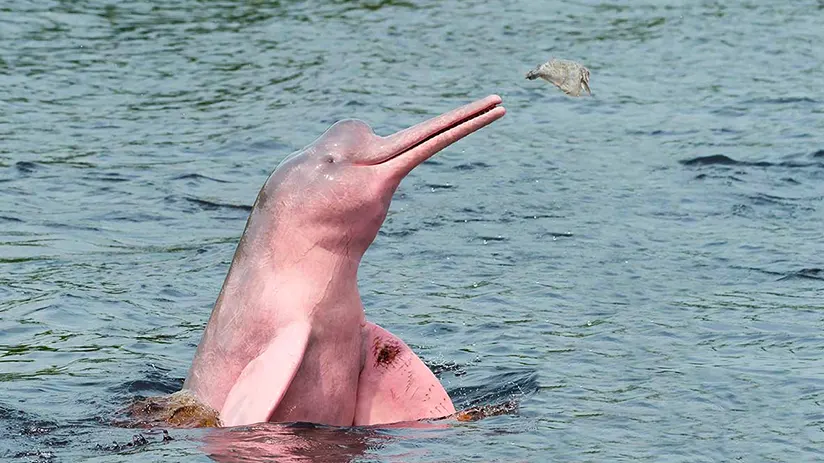
| Where to see them | Pacaya Samiria National Reserve. |
| Condition | Carnivorous. They don’t have predators. However, there are registers of anacondas attacking pink dolphins when they invade their territory. |
| Extinction Status | Endangered (EN) |
The pink river dolphins call the Amazon River home, as well as its different tributaries. The pink river dolphin is one of those Amazon animals that you will want to know about. Some tours offer the unique opportunity to swim alongside them.
Mothers commonly give birth to dark grayish babies. However, as babies grow old, they take on their distinctive pink color. Even its pink tones can increase according to its feelings, unbelievable! These dolphins have a small dorsal fin, large neck, round head, and a long and pointed mouth.
These swim in couples or groups of up to 4 members, unlike their gray cousins of the sea that go in numerous groups. Another difference with sea dolphins is the capacity to swim on their back and move their neck from left to right and vice versa.
They can even swim backward with one fin. Moreover, they usually live throughout the Amazon River basin, its tributaries, and some streams. Their diet consists of fish, freshwater crabs, frogs, river turtles, and even piranhas.
There are a wide variety of legends and myths surrounding this enchanting dolphin. Among them, some mention how during the night, dolphins transform into beautiful young men. They are friendly with humans. Unfortunately, this feature is expensive for them.
This fact is because they usually can die when close to the propeller or motor of any boat. Besides the pollution from the gas and oil industry that passes their pipelines through their habitat.
Therefore, while there’s time, choose to stay in many jungle lodges, or you can even take a luxurious river cruise. You will have the opportunity to see and photograph these enchanting animals at both locations. You can even enjoy swimming with them if you have the opportunity.
9. Puma
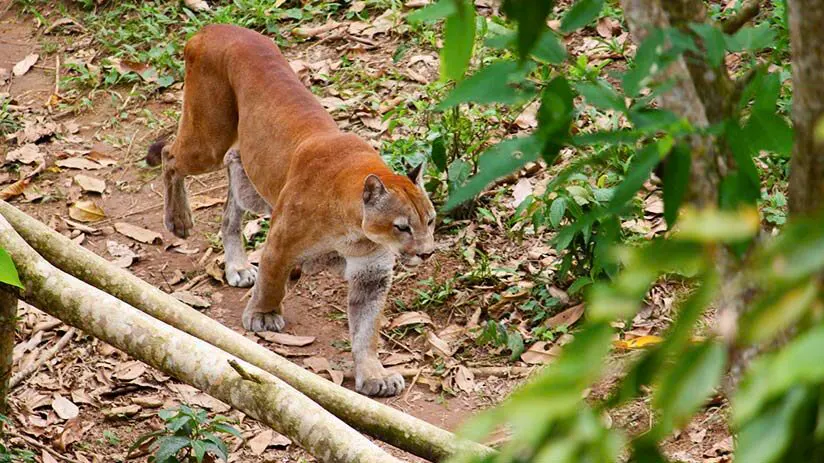
| Where to see them | Manu and Pacaya Samiria National Parks and Tambopata National Reserve. |
| Condition | Super Predator (Predator that hunts other predators) |
| Extinction Status | Near threatened species (NT) |
The puma is one of those Amazon rainforest animals that you do not know if they are legends or reality. It has both a graceful and fierce figure and posture. These jungle cats are a real sight to behold if you are lucky enough to spot them.
The probability of encountering one of these cats is quite low. Even if you plan to go deep into the jungle. Because they usually inhabit the high jungle and humid mountains. On the other side, its cousin, the Jaguar or Otorongo, lives in the low jungle zones.
Therefore, Puma is the second-largest wild feline in all of South America, just after the jaguar. With brown fur, strong legs, muscular hind legs to jump more than 20 feet, a wide head, a strong jaw, and sharp teeth, pumas are on the top of the food chain.
Often, they go solitary and haunt monkeys, birds, boars, armadillos, and capybaras. In addition, these animals can’t growl, as the majority of wild felines do. Instead, they can hiss, growl, and purr like any other domestic cat, but be careful! Don’t make the mistake of confusing them.
The significant mark of humans has made it somewhat difficult to spot these majestic animals. Even in moderately remote areas. One of the most incredible jungle predators to watch.
10. Bearded emperor tamarind
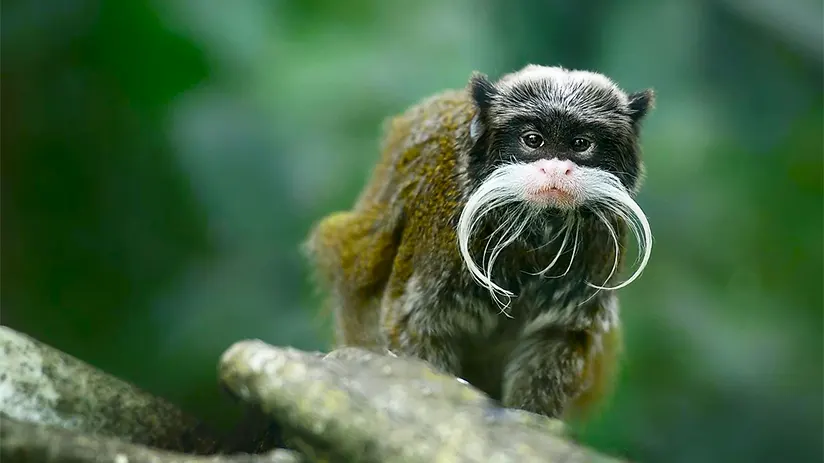
| Where to see them | Manu National Park and Tambopata National Reserve. |
| Condition | Omnivores. They can eat some plants, fruits, insects, and small animals. |
| Extinction Status | Least Concern species (LC) |
The bearded emperor tamarind monkey is a charming animal notable for its white mustache. Both males and females wear this distinguished and fun mustache.
This funny primate usually lives in communities of between 4 and 15 members. These bearded marmosets have gray fur with certain brown or yellow spots. They are often omnivores, so their diet comprises plants and animals.
These charming monkeys grow to 10 inches tall with a large tail that extends up to 15 inches. While its weight does not frequently pass the pound.
They run on all fours and can only see in two shades of color to better distinguish their predators. Some females can see in three colors. You will need luck to see these elusive friends through your Peruvian Amazon trip.
11. Amazonian tapir (Sachavaca)
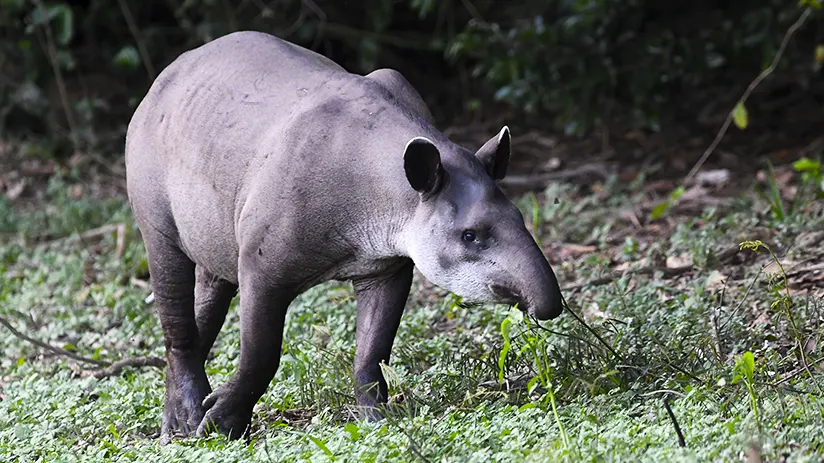
| Where to see them | Manu National Park and Tumbes region. |
| Condition | Vegetarians. Its predators are jaguars, pumas, and black caimans. |
| Extinction Status | Vulnerable (VU) |
You can find the Amazon tapir or Sachavaca in the middle of the rainforests and humid forests of Peru. At first glance, this animal can be so similar to a species of wild boar or wild pig, or even an anteater.
These Amazon tapirs are the second-largest on Amazon, just behind Manatees. Of course, you can identify them by their elongated snout, round ears, fat bodies, and short tails ending in a tuft of hair. Their stands are 30 to 43 inches large and weigh more than 500 pounds. But the truth is that these animals are distant relatives of rhinos and horses.
They are usually somewhat lonely and are habitually more active at night. In addition, they are expert swimmers, and they often run toward rivers when they perceive threats. It feeds mainly on vegetation that grows in or around rivers, shoots, fruits, and different herbs and leaves.
The mothers give birth to young tapirs with white stripes and spots that fade over time. Unfortunately, deforestation and poaching of their meat are big problems for them.
12. Manatees
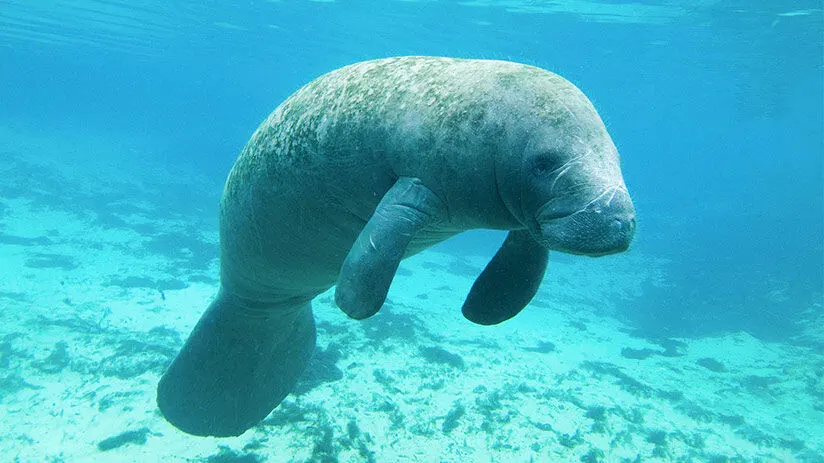
| Where to see them | Pacaya Samiria National Reserve. |
| Condition | Vegetarians. |
| Extinction Status | Vulnerable (VU) |
These sea cows (its other appellative) inhabit the shallow water of the Amazon basins, tropical zones, and coast waters. Of course, they inhabit the last zone with less frequency because their predator, the orca, lives there. The manatees are one of the largest mammals in the Amazon region and Peru.
They can reach between 5.6 to 6 meters large, and their weight range from 300 and 500 kilograms! Besides, they have a round and bulging body and a flat, horizontal, spatula-shaped rear fin. Its diet consists of riparian, mangrove, algae, and shallow seabed plants.
They often swim alone. However, females usually go with their babies. In the past, hunters hunted these animals excessively. Happily, the IUCN catalogs them as protected species, and they regulate their fishing.
Amazon rainforest birds
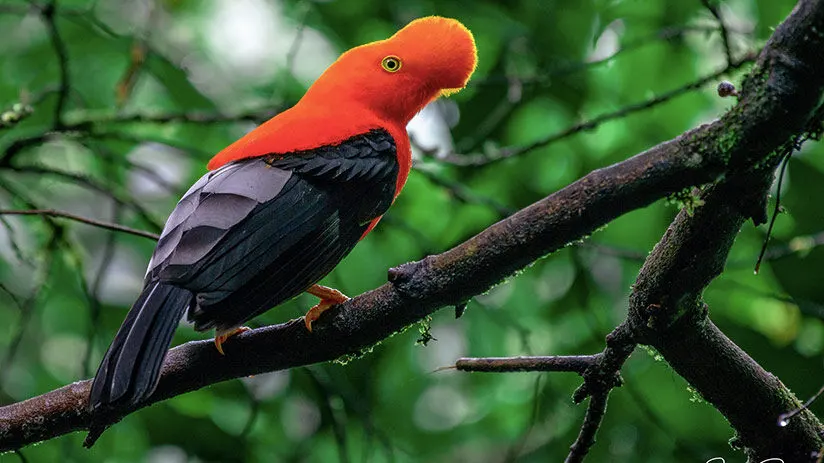
Undoubtedly, birds are the symbol of the Amazon’s biodiversity. The Amazon, the largest tropical forest in the world, is the perfect home for this bird kingdom, and even more so in Peru. The Peruvian Amazon has over 1,300 bird species that live and breed across 7 million square kilometers.
Because the Andean country has 80% of these bird species, it is now the second country with more bird diversity worldwide! Therefore, the tourism practice of Bird Watching in almost all Amazon regions of Peru. Dare to see the most representative Amazon rainforest animals of this kingdom below.
13. Macaw
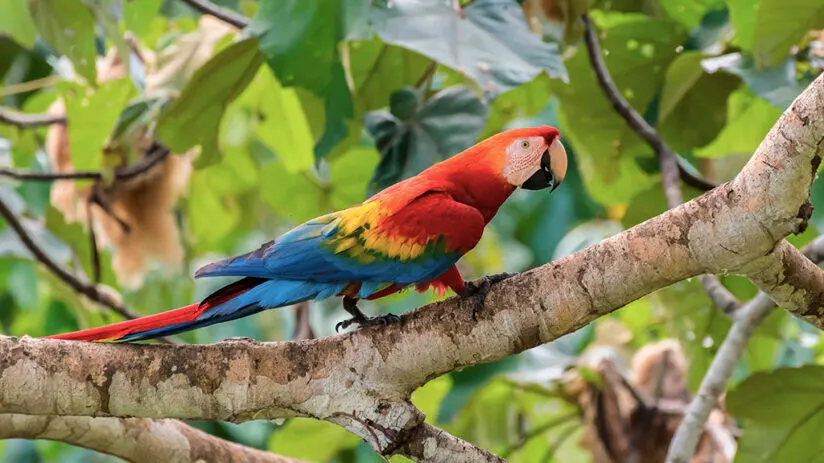
| Where to see them | In all of South America. In Peru, at Puerto Maldonado south department, near Manu National Park. |
| Condition | Vegetarian with a diet of seeds, fruits, and nuts of the native Amazonian palms. Its predators are jaguars and harpy eagles. |
| Extinction Status | Endangered (EN) -Majority of macaw species- and Extinct in the wild (EW) -Spix’s Macaw-. |
The macaw is a classic symbol of the Amazon in Peru. Its feathers can vary in different colors. However, red, yellow, green, and blue are usually the most common colors. Redbirds usually share other tonalities, like yellow and blue plumage.
Macaws can grow up to 3 feet and live in monogamous couples. They travel or eat, usually in flocks of 10 to 30 members.
They occupied all of Latin America’s regions, predominating in the tropical fortress of Central and South America. Their diet consists of seeds, fruits, and nuts of the native Amazonian palms. Among the different species, the scarlet macaw is one of the best known. This fact is because their distinguished colored, yellow, and blue feathers, you will see them everywhere.
Also, everybody knows their chirps throughout the Amazon region. Some domestic macaws can even reproduce human speech by imitation. It is common to see these birds gathered in the clay licks. There, they feed themselves with salt and other minerals.
Many researchers affirm that macaws consume salt to counteract the toxins of vegetable food that they eat previously.
Many visitors to Puerto Maldonado can see and take photos of these beautiful birds in the area. If you are looking to enjoy bird-watching tours, you will be able to see these birds in their natural environment. Inside the Manu National Park, you will get some great chances to spot these animals.
14. Cock of the rock
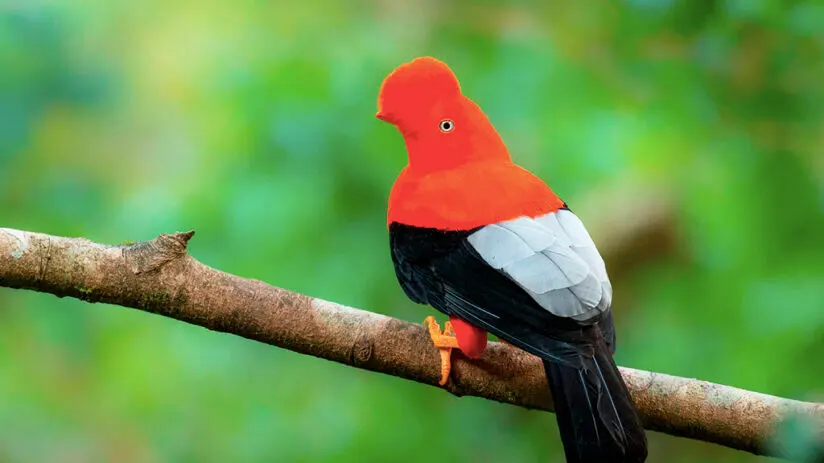
| Where to see them | Manu National Park. |
| Condition | Omnivores. Reptiles, insects, fruits, small mice, and amphibians. |
| Extinction Status | Least Concern species (LC) |
Considered the national bird of Peru, the Andean cock-of-the-rock is one of the most spectacular forest birds. Infamous for the various wildlife documentaries. The cock-of-the-rock is one of those must-see species for the biggest bird watchers and nature lovers.
Males have a deep orange color and black and gray wings with a striking orange crest. This crest is useful for courtship and mating dances and songs to attract the attraction of females. The specialist indicates that the males are polygamous and leave the raising of the chicks to females.
On the other hand, the females are opaque brown and gray. Their diet consists of fruits, insects, reptiles, small mice, and amphibians. This beautiful specimen lives also in some regions of the Andes and cloud forests of the Amazon.
Also, these cocks receive the appellative “Of the Rock” because they often live on ledges of some jungle rocks. So, make sure to check for this species within the different bird-watching tours.
15. Harpy eagle
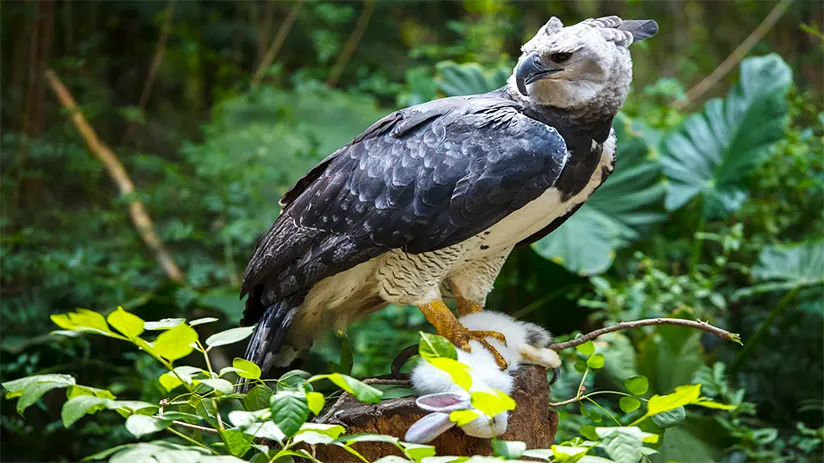
| Where to see them | Manu National Park and Pacaya Samiria National Reserve. |
| Condition | Predator. |
| Extinction Status | Near threatened species (NT) |
The Harpy Eagle is one of the most incredible Amazon animals to see. These giant eagles can weigh up to 20 pounds (male) and up 25 pounds (Female) and be wider than average human beings. With an intense eye, sharp beak, and claws larger than a Grizzly bear has, the harpy eagle eats monkeys, sloths, opossums, and even deer.
Scholars consider it the king of the jungle canopy. Since it usually dominates this entire area of the jungle and usually lives in pairs. They have a gray head, a white belly, and a complex pattern of white, gray, and black feathers on their wings.
Harpy Eagle is one of the largest eagles in the South American region, reaching 6.5 feet of large (with outstretched wings). And its habitat is the eastern rainforest of the Amazon in Peru.
16. Toucan
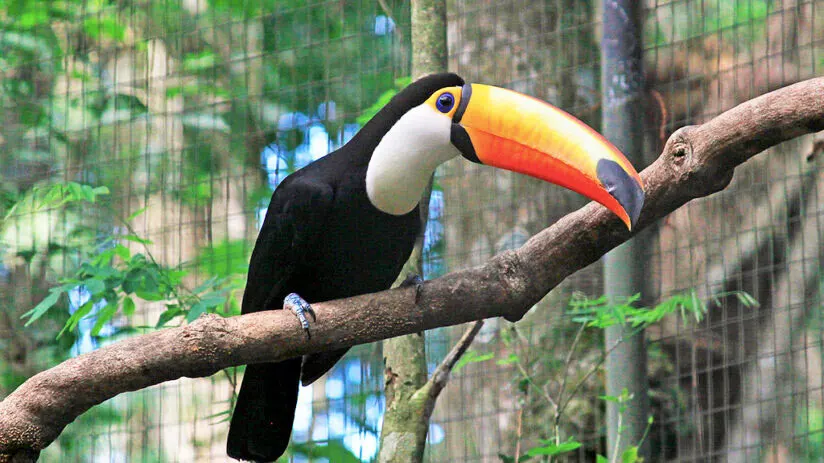
| Where to see them | Manu National Park and Tambopata National Reserve. |
| Condition | Oviparous. They eat insects, fruits, small reptilians, other small birds, and their eggs. |
| Extinction Status | Endangered (EN) |
Large, different-colored beaks are one of the most notable characteristics of toucans. These are large and can reach from 6 to 9 inches. Toucans are 7 different types of Amazon rainforest animals.
It has black plumage, and its chest can be white, yellow, or blue with an orange stripe near its eyes. Also, their bodies measure up to 20 inches. These are quite common in the Tambopata region of Peru, where you can see many species of toucans.
Toucans are sociable, and you can usually see them flying in groups at sunset. They are also oviparous birds that eat insects, fruits, small reptiles, other small birds, and their eggs. Toucan is easy to recognize because of its large and characteristic beaks. It is a relatively small bird, but it does not prevent it from standing out among other birds.
Toucans live in the south of Mexico, the Center of America, and the north of South America. Unfortunately, the IUCN cataloged him as an endangered species. This fact is because of heavy hunting and selling of them as pets.
17. Paradise tanager
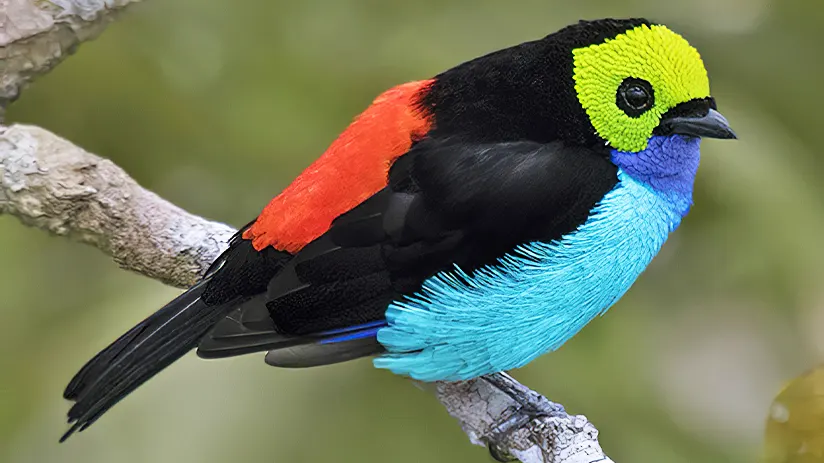
| Where to see them | Manu National Park, Pacaya Samiria, and Tambopata National Reserve. |
| Condition | Oviparous. They eat insects, berries, and fruits. |
| Extinction Status | Least Concern species (LC) |
This bird of different colors lives in the eastern Amazonian lands of Peru and Ecuador. The Paradise tanager also inhabits the areas south of Colombia and Venezuela, west of Brazil, and north of Bolivia. Its head is bright green, while its belly is deep blue, and the rest of its body has dark fur.
Both the females and the males are just as colorful. They can measure between 13.5 and 15 centimeters and weigh up to 20.5 grams.
The Paradise tanager is a bird that usually stands out in its natural habitat. Therefore, they nest high in the rainforest canopy of the jungle. This bird lives far from predators that might be looking for its eggs. Although occasionally to forage it moves between the perches in the middle of the trees.
The visitors can see them flying in mixed-species flocks between 4 and 20 members. Their diet also consists of fruits, berries, and insects. They don’t have many jungle predators, except the majestic harpy eagle.
18. Potoo bird
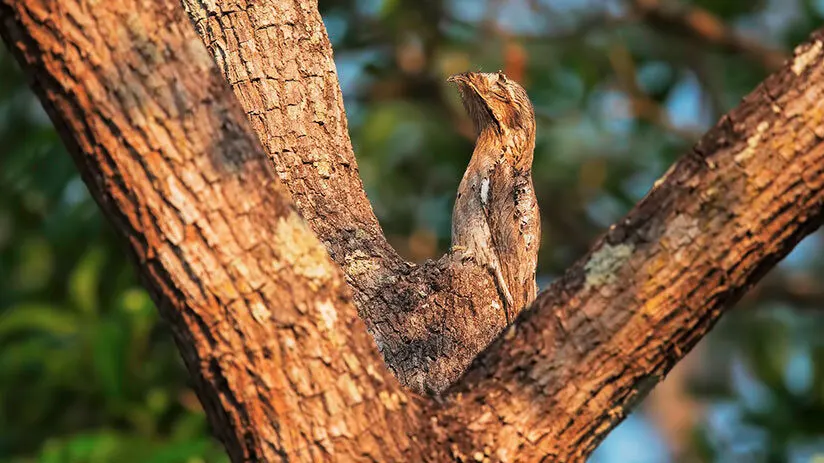
| Where to see them | Manu National Park, Pacaya Samiria, and Tambopata National Reserve. |
| Condition | Insectivorous. |
| Extinction Status | Least Concern species (LC) |
The potoo bird is a unique Amazon bird. This particular friend has brown and pale fur to resemble and camouflage with the trunk or tree branch where they usually spend the day. With tiny beaks but wide mouths, the Potoo birds are nocturnal and take advantage of the darkness to hunt moths, beetles, and other insects.
The Potoo measure ranges from 33 to 38 centimeters. This bird often lives on the tips of trees and their branches in almost all South American Amazon zones. Usually, they are solitaries and emit torn songs, even terrifying at night.
A legend says that a local native town suffered from a sudden pandemic outbreak. During the chaos, a mother abandoned her two children at the top of a mountain, close to a creek. There, they had abundant fruit, food, and a stream to save them from starvation.
The children had a good time until the evening when they began to miss her mom. So, they spent all night finding their town and praying to the sky, wishing they were birds to fly and return to their mother. The Amazon spirit took pity on them and turned them into birds.
So, they flew to its town, but no one lived there anymore; all had died. From this moment, the orphaned birds began to sing laments every night.
You might also be interested in: Birds of Galapagos Islands to see on your vacation
Amazon rainforest reptiles
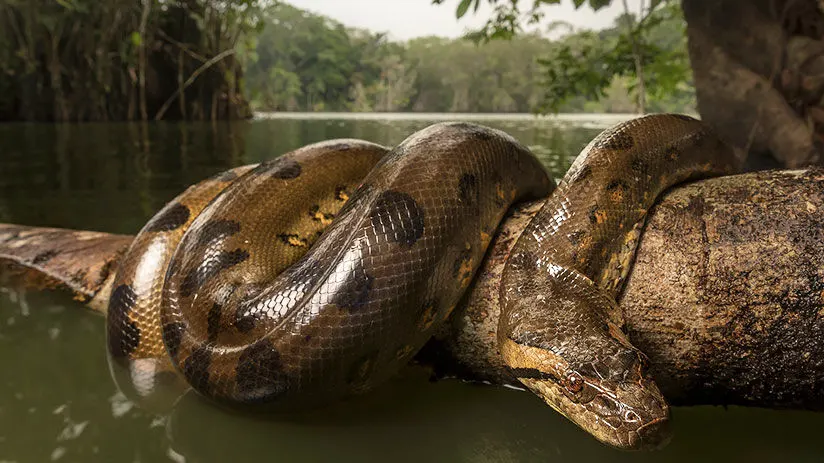
With more than 380 species of reptiles. The Amazon is a true paradise for these animal types. The two biggest superpredators among Amazon animals are in this category. We are referring to the giant anaconda and the imposing black caiman.
Therefore, the visitors demand a high to see both species. But don’t worry. If you are visiting the Amazon jungle with a local tour guide, you can enjoy the trip without any worries.
19. Black Caiman
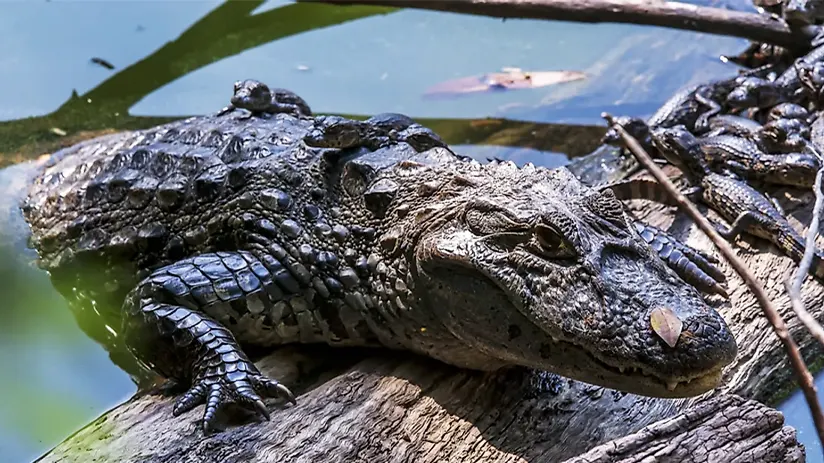
| Where to see them | Manu National Park and Tambopata National Reserve. |
| Condition | Super Predator (Predator that hunts other predators) |
| Extinction Status | Least Concern species (LC) |
Black Caiman is one of the most incredible and terrifying Amazon animals to see. It is the largest predator in the Peruvian Amazon Rainforest. The black caiman has dark scales that help it blend in with its surroundings.
It also has one elongated and straight snout and teeth that clench and grip but don´t tear. In addition, it has bony ridges over its eyes and a thick tail to defend against attacks and swim faster. They usually live in slow-moving water areas like swamps, mangroves, rivers, and streams.
Most of the time, visitors can only see them with their eyes loitering above the water because they enjoy staying in the water. By the way, black caiman can sink up to 30 meters deep. This crocodile grows to about 15 feet or 4.5 meters long and is quite large among alligators. Their diet may consist of deer, capybaras, fish, small reptilians, mammals, and especially tapirs.
They also eat other predators like jaguars and pumas, despite the fact that we have little record of these attacks. Moreover, its diet includes humans! Of course, when some innocent person invades their territory.
Currently, seven varieties of caiman exist. We can mention the spectacled caiman; that is the most prevalent, while the black caiman is the largest.
Usually, they are solitary, however, can live in couples, even groups of 4 members.
20. Green anaconda
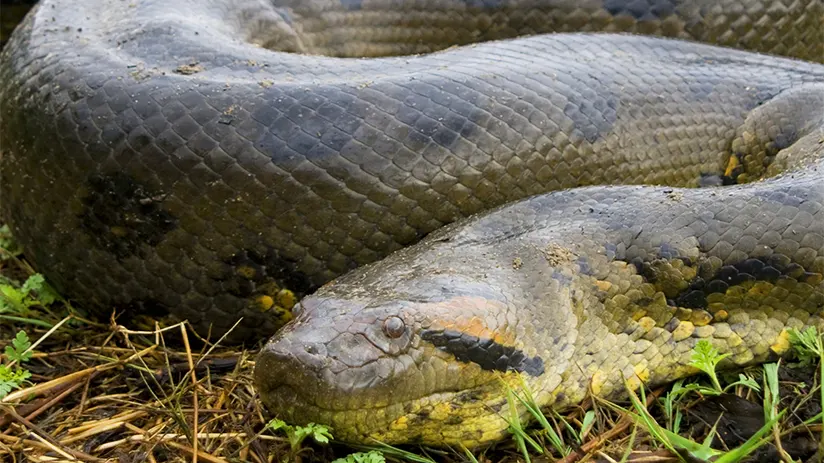
| Where to see them | Manu National Park and Tambopata National Reserve. |
| Condition | Predator. On the other hand, its predators can be jaguars and black caimans. |
| Extinction Status | Least Concern species (LC) |
Green anacondas are the second longest and heaviest snakes in the world. They can reach 7 meters in length and weigh up to 100 kilograms. The specialists consider it a solitary snake, not poisonous, and an incredible swimmer. Their eyes and nose are over their heads, so they can spend a long time with their bodies underwater.
They usually live in bogs, streams, and swamps of the rainforest. There, they usually hunt by suffocating their prey and then swallowing it whole. The green Anaconda is greenish and has circular spots in shades ranging from green to dark brown.
Their forked tongue helps them detect sudden changes in temperature and movement in the surrounding air. These water boas can be somewhat clumsy and slow on land. But swamps, marshes, and streams are best managed.
They have a varied diet that ranges from birds and turtles to other larger mammals. They have a very slow metabolism, so they can go weeks without eating after swallowing a big prey.
21. Side-necked turtle
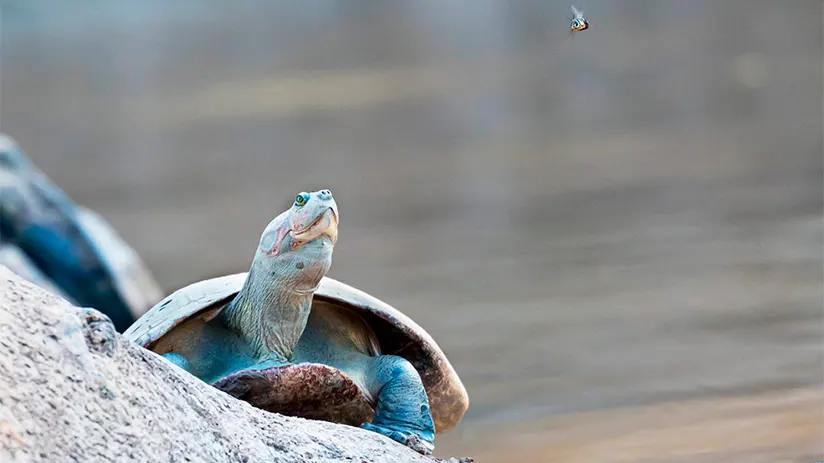
| Where to see them | Manu National Park. Pacaya Samiria and Tambopata National Reserve. |
| Condition | Vegetarians. |
| Extinction Status | Least Concern species (LC) |
Side-necked turtles receive a local name in Peru: Tortugas Charapa. They receive the name of side-necked turtles because they are unable to fit all their heads into their shells. And, to hide their heads, they must bend their necks to the sides, thus leaving a small part exposed.
These species often lay their eggs hidden in the sand along rivers. Its diet consists of vegetation, fruits, and flowers. But they also eat a freshwater sponge that grows on the trunks of trees during flood times.
Regularly they live in groups of up to 10 members. They inhabit streams and rivers of temperate or warm waters, preferably in subtropical environments. These Amazon rainforest animals can weigh up to 100 kilograms and measure between 70 and 100 centimeters.
And a curious fact is how butterflies usually drink the tears of these animals. The Side-Necked turtle is a way to obtain salt and other minerals that may be lacking in their diets.
Amazon rainforest amphibians
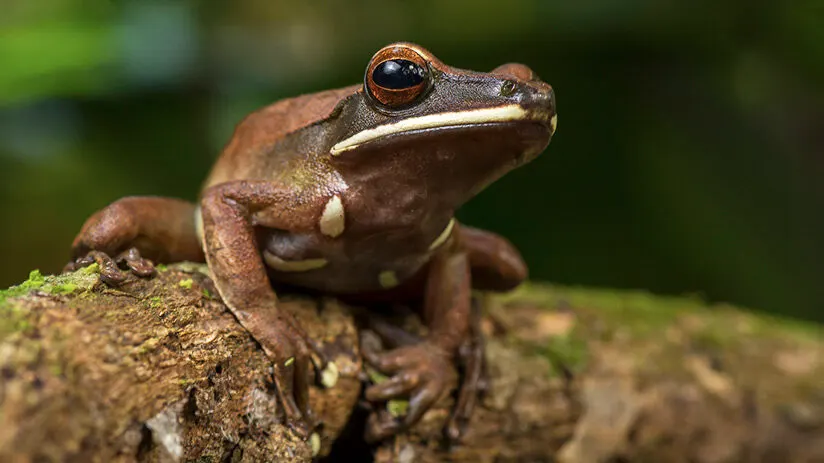
The amphibian kingdom inside the Amazon rainforest is priceless. They help to maintain the Amazon food chain (Because they are hunters and prey at the same time). With more than 400 amphibian species, scholars consider this class of animals a fundamental pillar of the Amazon’s balance. Also, among them, there is the most poisonous animal in the world!
22. Poisonous dart frog
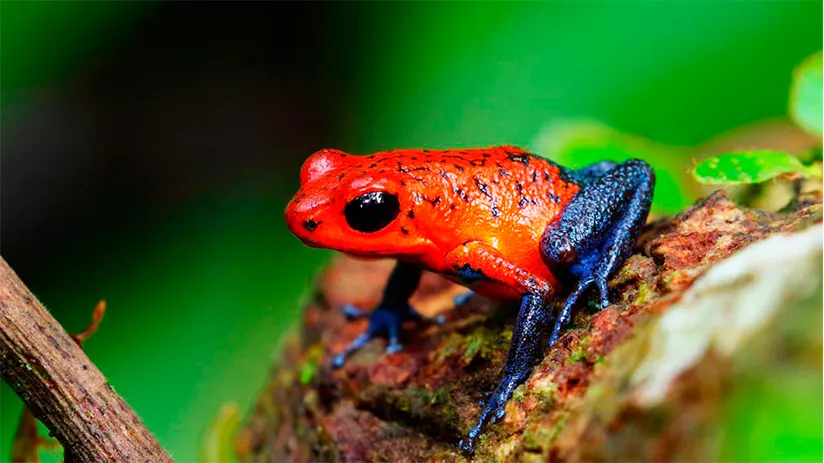
| Where to see them | Manu National Park. Pacaya Samiria and Tambopata National Reserve. |
| Condition | Insectivorous. They have almost no predators. |
| Extinction Status | Least Concern species (LC) |
In the Amazon, in general, you can find hundreds of species of amphibians and reptiles. The poison dart frog is a top contender when looking for the most colorful amphibians in the jungle. These small but dangerous frogs are some of the most poisonous creatures in the jungle. And as a warning, you can appreciate the intricate color patterns on its body.
You will be able to appreciate yellow, blue, and even red tones. It is precisely their bright colors that warn potential predators of how poisonous they are. Its diet consists of insects and some larvae. In adulthood, they can reach 55 to 65 millimeters.
The poisonous dart frogs are solitaries. Fortunately, the Peruvian red species has the least concern (LC) level on the Red List of global endangered.
You might also be interested in: Discover the best tours of Iquitos
Amazon rainforest fish
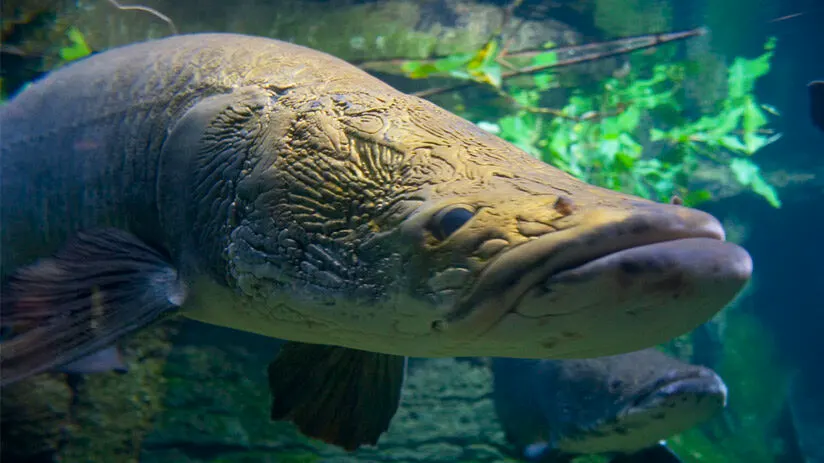
The Amazon rainforest receives the name of the main river that has its origin in Peru. This flows into the Atlantic Ocean on the Brazilian north coast, crossing Colombia. Therefore, the Amazon River is the largest world watershed.
It has more water than the Nile, the Yangtze, and the Mississippi rivers, all together! For this reason, no wonder when we say that more than 3,000 fish species live in its water, many of them endemic. These Amazon animals are different and unique. Below, you will see the three most renowned of these.
23. Piranhas
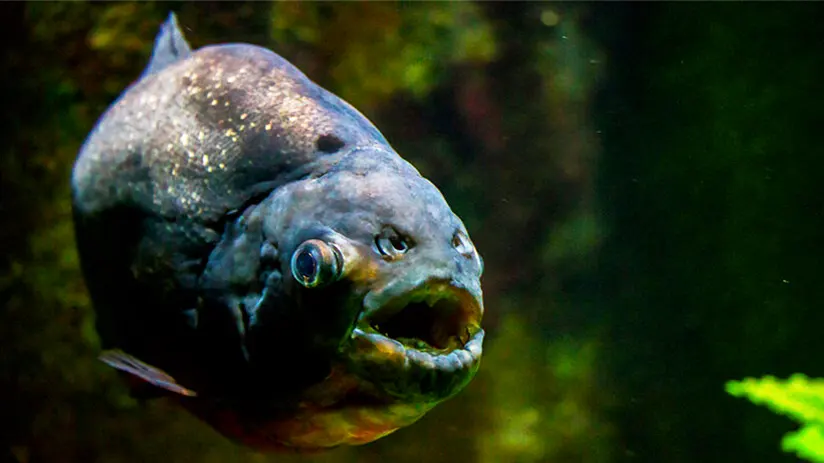
| Where to see them | Manu National Park. Pacaya Samiria and Tambopata National Reserve. |
| Condition | Carnivorous. Sometimes they can be omnivorous, too. |
| Extinction Status | Least Concern species (LC) |
The piranhas are not as aggressive as you can imagine. These carnivorous Amazon animals are scavengers and feed on plants, fish, crustaceans, worms, and insects. Only in extreme cases of starvation (which are usually few) can piranhas activate a fierce attack program.
Piranhas frequently form groups of up to 20 members or more to protect themselves. They also live in fast-water zones and nibble on the dorsal fins of other larger fish.
However, there is a register that they can live in slower freshwater streams, lakes, and rivers, too. Piranhas’ measure ranges between 15 and 25 centimeters. However, biologists found specimens of 34 centimeters in recent years.
They often attack when they smell blood in the water or feel hard vibrations in stagnant water. This last fact signals prey or young fish that don’t know how to swim well yet. Its predators are black caimans, pink dolphins, and big fish.
24. Electric eel
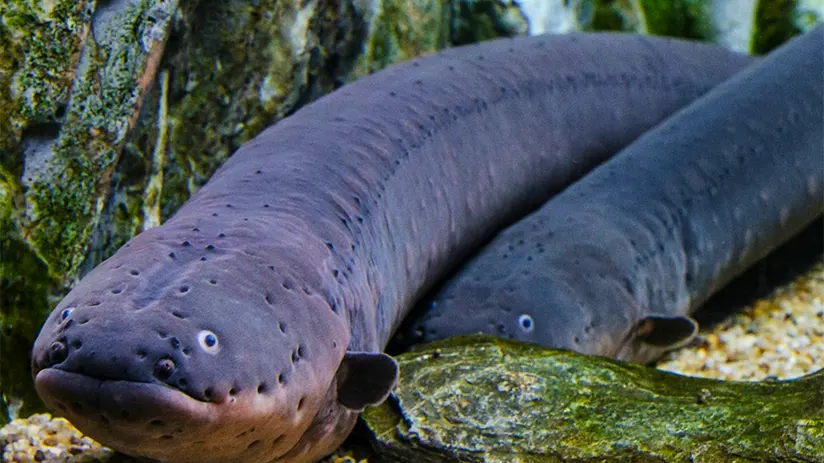
| Where to see them | Manu National Park and Tambopata National Reserve. |
| Condition | Carnivorous. |
| Extinction Status | Least Concern species (LC) |
Believe it or not, these Amazon animals are not eels. Quite the contrary, they are fish (a particular type, knifefish). They don’t have scales and have a square mouth with little teeth. In addition, these animals have a large body, similar to a true eel.
Of course, the organs near their abdomen produce electricity. This is their main defense system. They can paralyze their prey and stunt a human with a discharge of up to 500 volts.
Obviously, this attack is for those who invade their space. The electric eel is nocturnal and has poor vision. Therefore, they use electricity as a radar to localize prey and move very fast.
They live in muddy bottoms of stagnant swamps, streams, and floodplains. But rest assured, encountering them in the Peruvian Amazon rainforest is rare. It measures up to 2 meters and a half large, and one specimen can weigh up to 20 kilograms.
Its diet includes invertebrates such as shrimp and crustaceans, other fish, and even small rats. The hatchlings eat eggs of the same mother (unhatched eggs)
25. Paiche
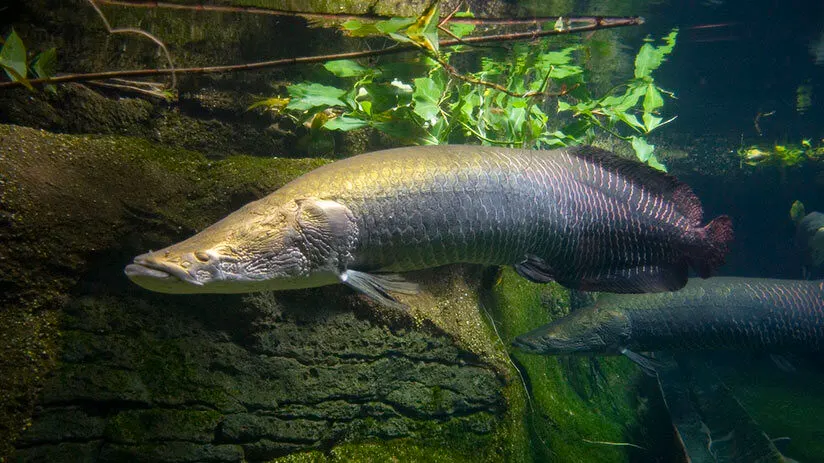
| Where to see them | Manu National Park. Pacaya Samiria and Tambopata National Reserve. |
| Condition | Carnivorous. |
| Extinction Status | Still unknown. |
Paiche is the second-largest fish in the world, just behind the beluga sturgeon (the Black Sea and the Caspian Sea). These animals can measure up to 3 meters large and weigh up to 250 kilograms. These animals have large and scaly bodies, strong dorsal fins, and slightly upward-sloping mouths.
This inclined mouth allows them to swim in poorly oxygenated water and take oxygen off the air. Therefore, the visitor will see only the Paiche’s mouth rising out of the water every 15 minutes.
They swim between tree bottoms. Of course, when the water level is low, they often bury themselves under the mud by leaving only their mouths exposed to breathe.
Its diet consists of other fish, even birds that catch to jump over the river level. Paiche is solitary. However, biologists can sometimes see them swimming in pairs.
In the 1970s, 1980s, and 1990s, the appreciation of their meat put them in danger. Therefore, NGOs and other organizations created many refuges and conservation centers throughout the Amazon basins. These refugees are especially where the Paiche live.
The International Union for Conservation of Nature, IUCN, does not know its population or conservation status nowadays. However, research is still developing.
Amazon Rainforest Insects
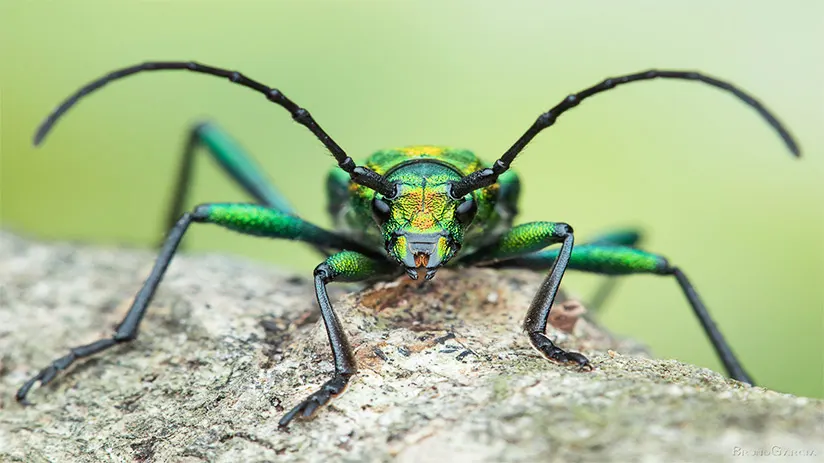
Just a single hectare of Amazon forest can host Around 40,000 insect species. This represents 90% of the total wildlife there. Just Amazing! For example, you can find 1300 insect species only in the Manu National Park.
Taking into consideration that the Manu has around 17,200 square meters. This means that one can find 1300 insect species, more than the 500 species in Europe. But don’t worry. Among much variety, we have selected the 5 most striking insects in the entire Amazon!
26. Leafcutter ant
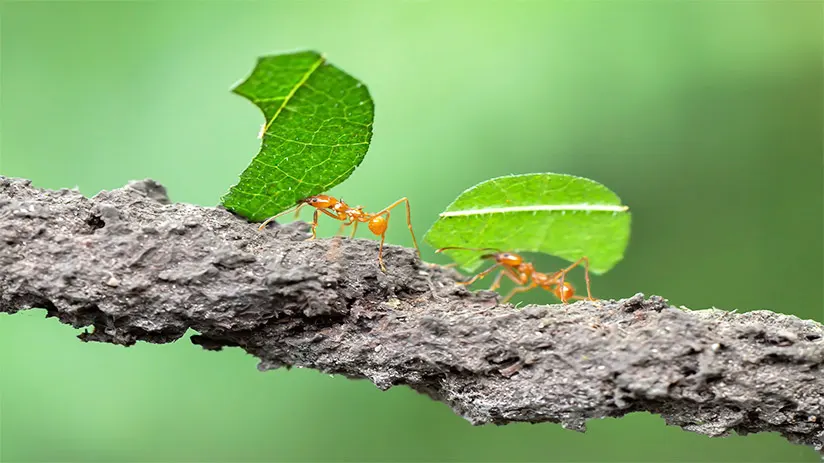
| Where to see them | Manu National Park, and Tambopata National Reserve. |
| Condition | Herbivorous. |
| Extinction Status | Still unknown. |
If you see large leaves moving on their own in the jungle, don’t worry. They are leaf-cutter ants carrying leaves that are five times heavier than them on their backs. These ants cut and ingest them and then grow fungi on the chewed leaves.
After, they put these chewed leaves under poisonous plants, making them edible. In addition, these fantastic ants can form mounds up to 30 meters wide. Of course, they also form small mounds around the big one within a radius of 80 meters. In this way, each group of these mounds can house more than 8 million ants.
27. Peanut head bug
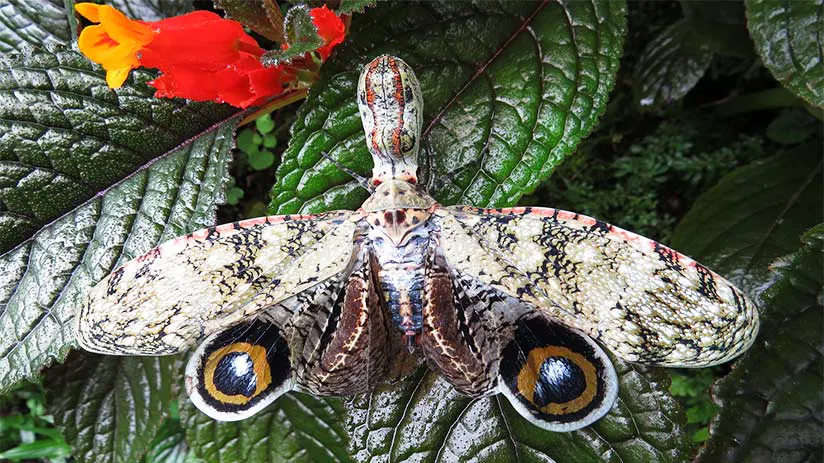
| Where to see them | Manu National Park, Pacaya-Samiria National Reserve, and Bahuaj-Sonene National Reserve. |
| Condition | Herbivorous. |
| Extinction Status | Still unknown. |
This is perhaps the strangest butterfly in the Amazon in terms of shape. The Peanut Head Bug measures around 85 to 90 millimeters long. It also has a head (23-24 millimeters) that resembles a peanut.
However, the bug has false eyes at the end of its wings, which, when extended, resemble the eyes of a lizard. Just Amazing! This butterfly can only defend itself by mimicking a lizard’s eyes with open wings.
Because it has no other defense mechanism against predators. In other words, they don´t sting or bite. However, in recent years, scientists discovered an unpleasant-smelling substance that it expels when attacked.
28. Goliath birdeater
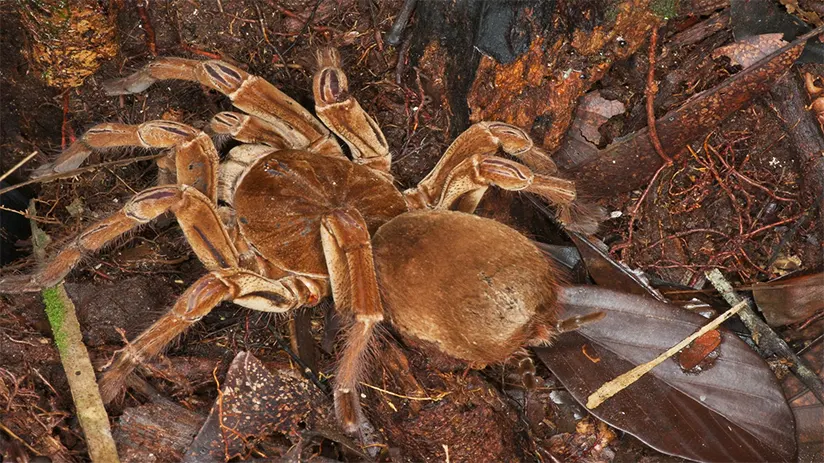
| Where to see them | Manu National Park, and Bahuaj-Sonene National Reserve. |
| Condition | Insectivorous and sometimes carnivorous. |
| Extinction Status | Still unknown. |
If you have a phobia of arachnids, the Goliath birdeater will be your worst nightmare. Its large size shows the freedom and disposition that this spider has had growing in the middle of the Amazon. The Goliath birdeater measures around 28 – 30 cm. If you fully extend your hand, you may realize this spider is bigger than your outstretched palm!
Also, these can weigh around 100 to 155 grams. The females are the largest, most aggressive, and solitary. These tarantulas only come together when mating and when caring for their eggs. They have hairy, yellowish-brown bodies.
Their venom is deadly if the victim doesn’t receive immediate medical treatment.
29. Blue morpho butterfly
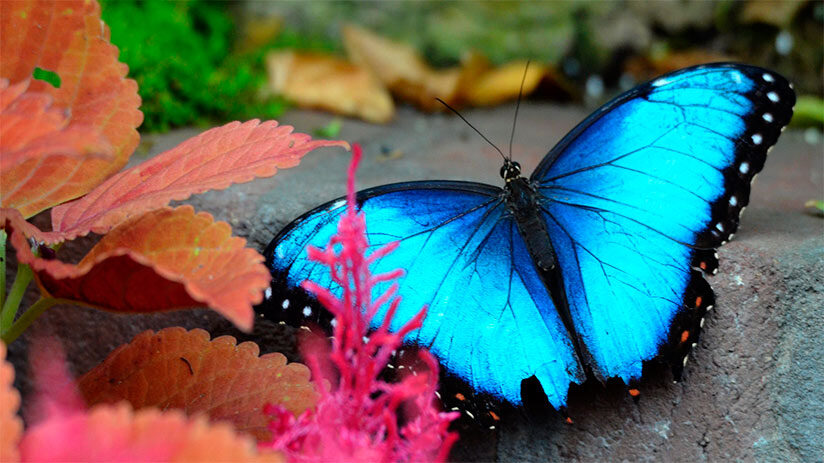
| Where to see them | Manu National Park, Pacaya-Samiria and Tambopata National Reserve, and Bahuaj-Sonene National Reserve. |
| Condition | Herbivorous. |
| Extinction Status | Vulnerable (VU) |
This is the most beautiful butterfly in the Amazon. Its wings are entirely reflective blue. Of course, the butterfly can measure between 7.5 and 20 centimeters with the wings extended.
Their life is incredibly short (115 days). In addition, they are usually solitarily hovering close to the ground.
Only in the mating season do they go up to the tops of the forest in search of a partner. Pilots flying over the Amazon claim to have seen many Blue Morpho butterfly colonies. These are gathered in one determinate area of the forest. This creates a beautiful sight for the pilots.
30. Urodid moth cocoon
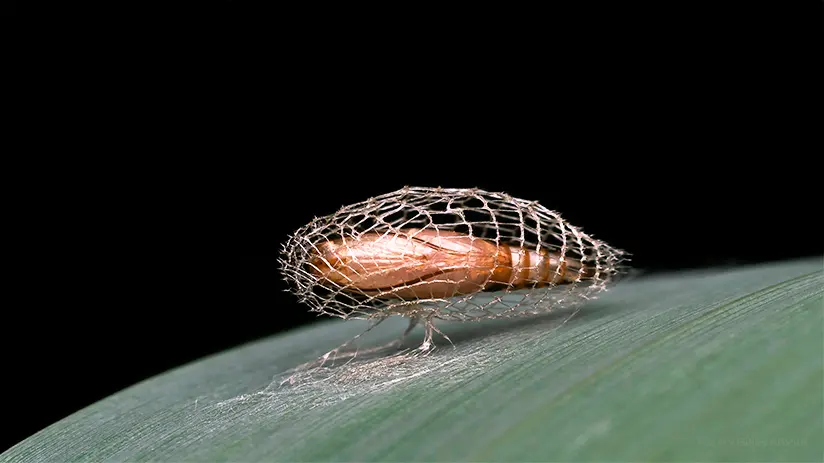
| Where to see them | Manu National Park. |
| Condition | Herbivorous. |
| Extinction Status | Still unknown. |
This fantastic butterfly, with translucent wings and Amber detail, resembles a ghost. They live in the depths of the forest, in shady parts. The open structured cocoon allows air to flow over the pupa, preventing mold and fungus growth. After the pupa grows, the butterfly emerges from a small hole at the bottom, becoming a new ghost butterfly.
“UNTIL ONE HAS LOVED AN ANIMAL, A PART OF ONE’S SOUL REMAINS UNAWAKENED”
Obviously, there are a lot of Amazon Rainforest Animals to mention all within one list. But these are some of the most recognized specimens within the Peruvian Amazon. To learn more about our tours in the Peruvian Amazon, talk to our expert advisors for information and assistance.
We suggest visiting the Tambopata and Manu regions for amazing bird and animal sightings during various tours. It in a lifetime opportunity where you can enjoy and photograph large specimens of exotic animals. Machu Travel Peru hopes to have encouraged you a bit. If you want to know more about our tours, you can consult with our qualified advisors.
Peru has so much to offer, it can be hard to know where to start. With many years of experience in the tourism sector, Machu Travel Peru is happy to help with anything regarding your trip to Peru and any tours around it. Let us help you make your Peru travel experience unforgettable! Contact us today to plan your dream adventure.
